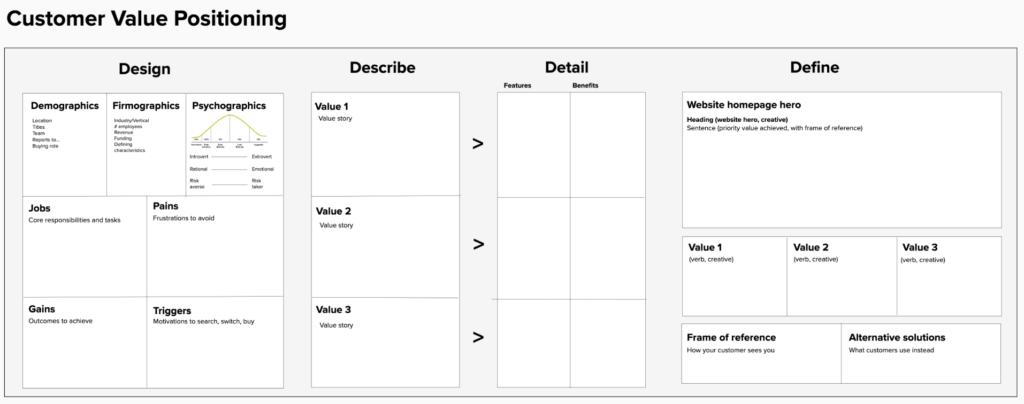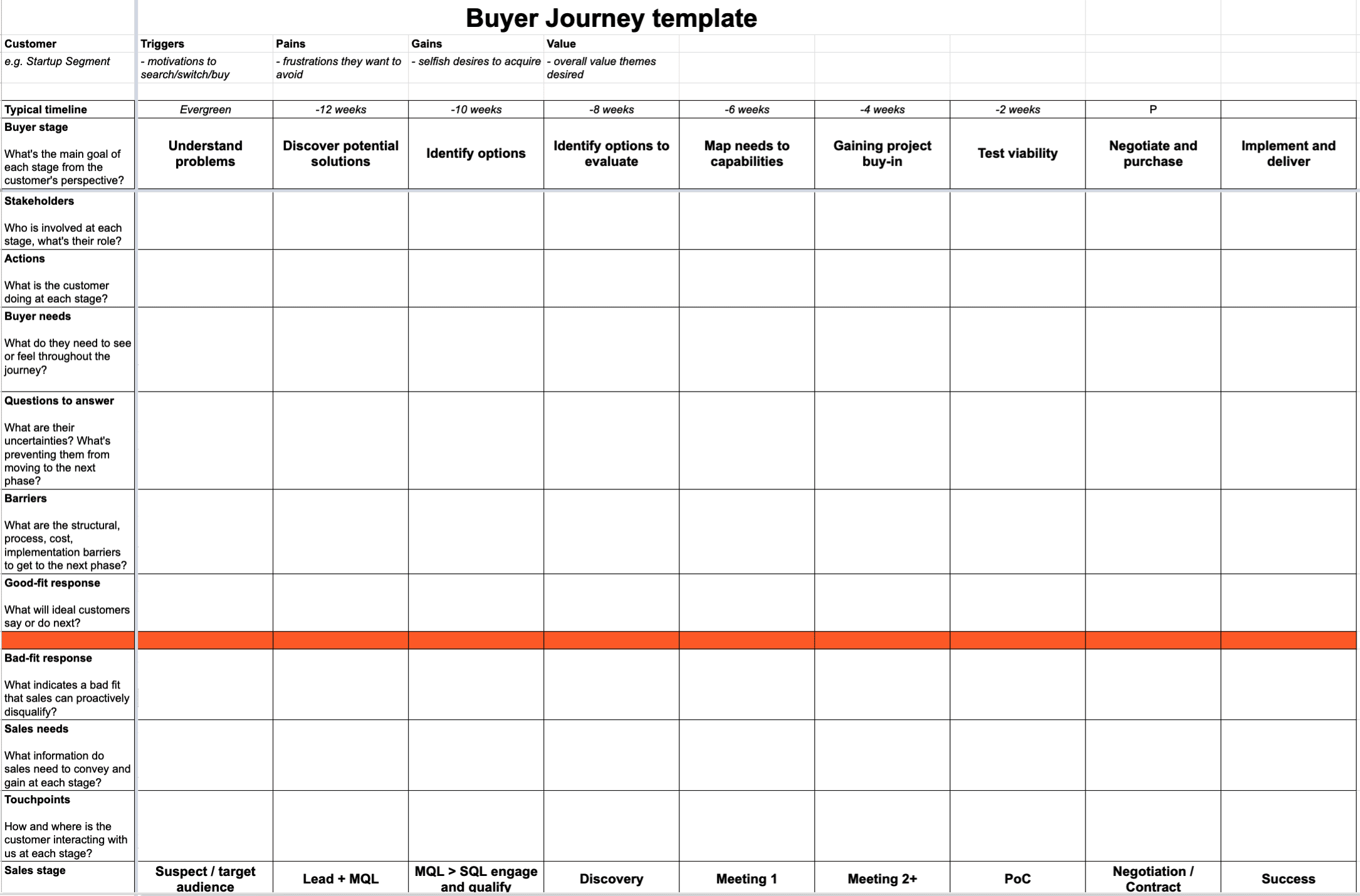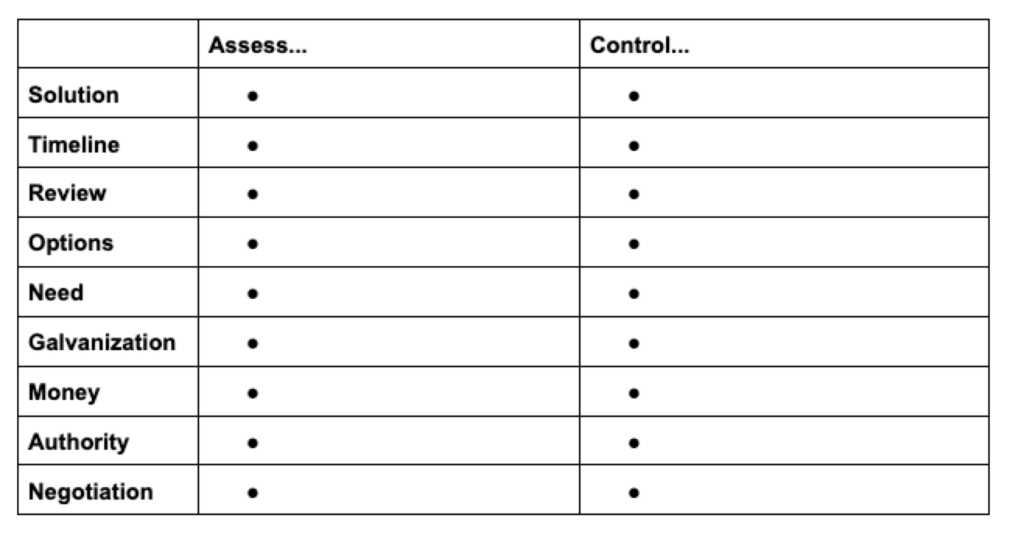Hi, I’m James. Thanks for checking out Building Momentum: a newsletter to help startup founders and marketers accelerate SaaS growth through product marketing.
Over the last one year and eight months (!) I’ve shared six product marketing templates that you can use in your business, on a range of topics from pricing to sales review to positioning.
Here’s a recap of the templates that you can download right now.
In this post:
Free Positioning Template

Over the last 5 years, I’ve cultivated a positioning process that I call Customer Value Positioning.
I’ve written about all of the component pieces on this newsletter so regular readers will recognise the themes, but it’s taken me the last 12 months to revise, simplify, and improve based on the feedback of over 20+ marketers.
With Customer Value Positioning (CVP), you’ll:
- Define the perfect website heading and slogan that resonates
- Detail exactly how your product helps your customer achieve their goals
- Describe the top three outcomes your customers desire
- Design a fluff-free persona that aligns your sales, marketing, and product teams
And, just like the name might suggest, we’re basing the whole process on the only thing that matters: your customer.
Read more and get the template
Free Positioning Research Interview Template

Positioning-by-assumption doesn’t work. When we want to build momentum, supercharge growth, and increase sales, we need real customer insight to build powerful positioning.
Sure, assumptions – the result of our experiences – are useful, a form of internalized pattern matching. But our biases, limited exposure, and and a lack of subject matter expertise often prevent assumptions from being useful in the real world.
Sometimes we can go further. We can determine inferences; conclusions we draw based on our observations. While these may begin in good faith, these (again) can often be biased and pre-determined in nature. What may start as truthful observations can quickly become layered in opinion. There are always three truths: your truth, their truth, and the real truth.
So we should aim to build evidence. Direct from your customer.
But it’s difficult to know where to start. Who do you ask? What do you ask? How do you use that information?
I’m sharing my customer development cheatsheet – 19 high-value questions designed to extract maximum insight from customer research interviews.
Read more and get the template
Free Buyer Journey Template

The buyer journey should be well-documented, highlighting and prioritizing what customers need and the questions they ask at each stage in the process. This aligns with your internal sales process, mapped to stages in the funnel.
Each stage of the buyer’s journey should analyzed to understand what the buyer wants to know – and should know – by the time they move onto the next stage. This is then aligned into key sales activities at each stage: your discovery call, meeting one, demo, and so on.
This is really key to many parts of your Go-To-Market strategy, but is complex to develop.
Every single person you speak to – from buyers, champions, to sales reps, and subject matter experts – will describe their buying process both wildly differently and completely unhelpfully. They were (and are) so enveloped in the process, they’ll find it hard to step back and look at the big picture.
Read more and get the template
Free GTM Strategy Template

Probably the most overused, yet most misunderstood word in SaaS?
Go-to-market is often used to refer to everything that happens in a business outside of engineering and core functions like finance and HR.
Often this isn’t defined as a single strategy, but as an amalgamation of everything you’re already doing. Even to those in the know, GTM can feel really intangible – and extremely difficult to communicate internally.
And if it’s difficult to communicate amongst different teams, are you sure you’re all rowing in the same direction?
Read more and get the template here
Free Pricing Objectives Template

Everybody has a reasoned and valid opinion on how pricing should be set, from experience with past companies, watching competitors, ‘best practices’ articles, or even individuals influenced by the ‘IKEA effect’ bias. Rarely is there any alignment on the pricing objectives: the goal that pricing should help you achieve.
As a product marketer or person in charge of coordinating pricing, you might be tempted to lock stakeholders in a room and wait with baited breath for them to walk out, smiles and handshakes all around as they celebrate their new-found alignment.
Except… that doesn’t happen! You may appear to have a grasp of loose objectives, only to discover everyone else still has a different understanding. You can still be dealing with fallout from decisions that didn’t have full buy-in months after implementing.
So what should you do to keep your pricing process on track, and gain the confidence you need to move forward?
Read more and get the template
Free Sales Deal Review Template

In the rush and excitement of building and executing a startup sales process, it’s tempting to relax discipline in exchange for activity.
After all, there’s so much more to be doing: you need more opportunities, you need more conversations, more networking, so you’re too busy to make notes. Right?
Not quite…
If anything, it’s even more crucial to make sure you’re recording the right information to help you gain control of your pipeline, assess performance, and extract useful insights to improve your sales results. But how?
Read more and get the template
Thanks for reading! Let me know what you thought – find me on Twitter and LinkedIn.
P.S. If you’ve found value in Building Momentum, could you buy me a coffee? Here’s my tip jar – any support is gratefully appreciated!
P.P.S: If you enjoyed this post, will you share Building Momentum with your network?




